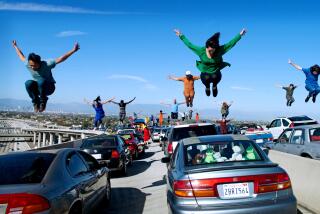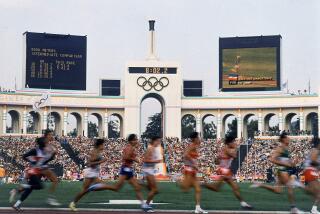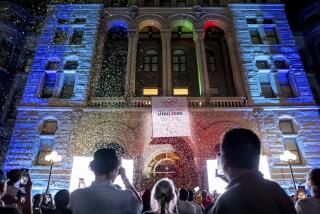Winter Olympic Wonderland : Snow, Readiness and Prices Are High in Lillehammer Less Than a Week From Opening Ceremony
LILLEHAMMER, Norway â As members of Lillehammerâs bid committee waited in the garden of a Seoul hotel in the summer of 1988 for International Olympic Committee President Juan Antonio Samaranch to read the name of the city that would organize the 1994 Winter Games, their leader, Petter Roenningen, was nine time zones away.
The banker thought little more of Lillehammerâs chances than he had when he first suggested the idea to other town leaders in 1977. âIt was just a joke,â he said. Even Crown Prince Harald, who is now Norwayâs king, called it a âwild idea.â
Roenningen and his colleagues, however, made enough of an impression during their first bid, for the 1992 Winter Olympics that were awarded to Albertville, France, that the IOC encouraged them to return. In Korea, they again expected to win the prize for congeniality and nothing more.
On the night before the IOCâs vote, in a party for the bid committees from Oestersund, Sweden; Sofia, Bulgaria; Anchorage, Alaska, and Lillehammer, the Norwegians were easy to pick out of the crowd because they were the most carefree, sporting red noses to match their red blazers after numerous toasts to their Swedish neighbors.
Oestersund was the favorite, so much so that Samaranch was overheard the next afternoon, before receiving the sealed envelope with the results of the voting, practicing the pronunciation of the name.
By then, Roenningen was back home. He figured it would be considerably more fruitful to be in Lillehammer for the opening of the hunting season than to be in Seoul to commiserate with the other losers.
Other members of the bid committee were no more optimistic, which is why they sat for several moments in stunned silence when Samaranch, without practice, mispronounced the name of the winner as âLilly-hammer,â instead of the correct Lill-uh-hammer.
Listening on his car radio, Roenningen was so shocked he almost drove off the street, which minutes later was filled with virtually all of the 23,000 citizens of Lillehammer, the smallest city other than Lake Placid, N.Y., to become an official Olympic host.
The national drink, aquavit, flowed for 48 hours before the people sobered up to the challenge ahead of them.
The Lillehammer Olympic Organizing Committee (LOOC) sought to inspire confidence, adopting the slogan, âThey Said It Couldnât Be Done, but Weâll Do It.â When some Norwegians complained that all that did was advertise their insecurities to the rest of the world, the slogan was abbreviated, âWeâll Do It.â
Today, as the digital calendar in LOOC headquarters counting down the days until next Saturdayâs opening ceremony reaches 6, it appears as if they were right.
Storefronts on the picturesque main street, Storgata, are made up like a debutante at her coming-out party. State-of-the-art venues have seals of approval, not only from athletes but also from architects and environmentalists. Sewers have been upgraded, roads widened and trains and buses added to accommodate the estimated 100,000 persons who will visit here during each of the 16 days of the Olympics. Most of them will stay 110 miles to the south, in Oslo, because there are only 3,100 hotel beds in the region.
Even the weather has gotten into the spirit. For five years, no self-respecting snowman would be found in Lillehammer, a condition so worrisome to organizers of the ski competitions that they enlisted the aid of snow-making cannons. But so much snow has fallen this winter that 7,000 truckloads are being carted out each day. Enough is still standing--more than nine feet in places--that fences built to separate spectators from competitors at some outdoor venues have been buried.
As evidenced by the 3,000 miles of cross-country skiing courses in the region, and the fact that Lillehammer is the worldâs only known city with a skier in its coat of arms, those who live here enjoy snow. But this is too much of a good thing.
Like a scene out of the television show âNorthern Exposure,â a moose in search of food was spotted two weeks ago on Storgata, and elk have abandoned the pine forests for more open spaces.
People have had to forage through their basements for standing sleds, called spark s, that enable them to travel through the snow quickly and safely. But despite the inconvenience, they understand that they are helping to create a favorable ambience. The Lillehammer that will be seen on television throughout the world is a winter wonderland, and that was the image the town leaders had hoped to sell when they bid for the Winter Olympics.
A stopover on the Kingâs Road between Oslo and Trondheim during the Middle Ages, Lillehammer was a commercial crossroads for centuries, then a market town that attracted the regionâs farmers, who were immortalized in Henrik Ibsenâs âPeer Gynt.â
The road to prosperity in the modern ages, however, is lined with tourist dollars, and Lillehammer found itself losing to Norwayâs fiords.
Located at the north end of Lake Mjosa, Norwayâs largest body of fresh water, Lillehammer became popular among Scandinavians for summer vacations. But the city also aspired to be recognized for its winter beauty, which has been captured for years by native artists, whose landscapes show off snow-covered rolling hillsides and an ethereal, pastel-shaded light.
To become a winter resort today, though, requires not rolling hillsides but mountains, and although there are a couple near here, they were not developed, even after Norwegians caught Alpine skiing fever in the 1970s. Before then, only cross-country was considered true skiing.
To catch up, town leaders knew they needed the impetus of the Olympics. But to get the Olympics, they needed slopes. To their credit, they were able to convince the IOC that they could create mountains out of molehills.
That, however, was not the decisive factor in Lillehammerâs favor. Numerous reasons for the IOCâs vote have been advanced, including an outrageous one involving Eastern Bloc pique over Swedish treatment of Soviet submarines, but it was probably tradition that carried the day.
Although 4,000-year-old rock carvings depicting men on skis have been discovered north of here, allowing Norway to proclaim itself âthe cradle of skiing,â and its athletes have dominated competition in Nordic sports for decades, the IOC was sensitive to the fact that the only time the country has served as host of the Winter Games was in 1952 at Oslo.
The IOC also was impressed by Lillehammerâs plan for an Olympics that would be inexpensive and compact, neither of which materialized.
âWhen we got the Games, all the cities that hadnât offered a single Norwegian kroner for the bid wanted a piece of the cake,â Roenningen said.
As a result, the federal government decreed that Lillehammer would share venues with the entire valley, which covers 72 miles and includes two larger cities, Hamar and Gjovik, each of which has a population of about 26,000. On the regionâs primary highway, a two-lane farm-to-market road that is often icy and always congested with trucks, travel is tedious.
The federal government also responded to pressure from environmentalists, insisting that organizers stage the greenest Games ever. The site of the speedskating venue in Hamar was altered to leave a bird sanctuary undisturbed; a hockey rink in Gjovik was constructed inside a mountain, and fines of up to $10,000 were assessed for cutting down trees unnecessarily.
Suspecting that ski resorts in other parts of Norway were siding with environmentalists in an attempt to prevent one from being built in his city, the mayor of Ringebu, site of much of the Alpine skiing, pulled the cord on the chain saw that brought down the first tree there. In the subsequent election, his opponent labeled him âthe Chopper of Ringebu.â
The mayor kept his job, but other politicians in the region who fought the environmentalists did not. A poll in Norway revealed that 67% of the people considered protecting the environment the number one aim of the Olympics.
In return for its interference, the federal government picked up most of the tab for the $1.05-billion budget, which is four times higher than originally projected.
The people here have not complained about the expense, perhaps because they expect to get rich. Tourists complain about the high prices, such as $8 glasses of beer, $3 cups of coffee and $600 hotel rooms.
Government officials, pointing out that Norway is one of the worldâs most expensive countries, report that they have found few instances of price-gouging, but LOOCâs president, Gerhard Heiberg, warned: âPrices are too high. These people are cutting off the branch they are sitting on.â
Heiberg, however, predicted that these Olympics will be remembered as the best ever âjust out of the sheer joy of our people.â
That might not be apparent to visitors because of the stereotypical Norwegian stoicism. A local businessman donated $70,000 to send merchants from the region to a charm school, which included a course in smiling. Only six enrolled.
Time Difference
Norway is nine hours ahead of Pacific time. So, when it is 8 p.m. in Southern California, it is 5 a.m. in Lillehammer.
Measurements
If you know... Multiply by To get Millimeters 0.04 Inches Centimeters 0.4 Inches Meters 3.3 Feet Kilometers 0.62 Miles
Temperatures
If you know Celsius, multiply by 9/5ths, then add 32 to get Fahrenheit.
More to Read
Go beyond the scoreboard
Get the latest on L.A.'s teams in the daily Sports Report newsletter.
You may occasionally receive promotional content from the Los Angeles Times.






